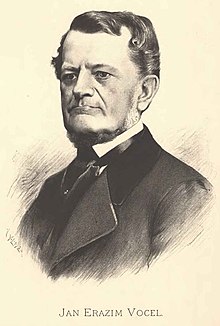| Jan Erazim Vocel | |
|---|---|
 Photo portrait by Jan Vilímek Photo portrait by Jan Vilímek | |
| Born | (1802-08-23)23 August 1802 Kutná Hora |
| Died | 16 September 1871(1871-09-16) (aged 69) Prague |
| Alma mater | Charles University University of Vienna |
| Occupation(s) | Czech poet, archaeologist, historian and cultural revivalist |
| Years active | 1820–1871 |
| Spouse(s) | Barbora Jaroslava Vocelová, née Štětková (m. 1843–died 1846); Matylda Vocelová, née Hovorková (m. 1849–his death, 1871) |
| Children | Růžena Vocelová (c. 1844–1846) Jaromirz Vocel (*1850) Vojtěch Vocel (*1851) Adalbert Vocel (*1851) Ladislav Vocel (*1854) Ludmila Vocelová (*1860) |
Jan Erazim Vocel (23 August 1802–16 September 1871) was a Czech poet, archaeologist, historian and cultural revivalist. Though as heir to his father's trade, he was to become a baker, his parents, observing his youthful enthusiasm for Gothic history, eventually heeded his academic calling.
Early life
Vocel was born in Kutná Hora. At the age of 14, he moved to Prague to attend a Piarist college-preparatory high school. Concomitantly, he attended philosophy lectures at Charles University. Already by that time, he had begun writing fiction, of which efforts only two complete works survive—Krvočíše (Bloodshot), a romance about growing grapes in celebration of Charles IV (King of Bohemia and Holy Roman Emperor), and Harp (1875), a tragedy. On graduating, Vocel departed from Prague to Vienna, where he studied philosophy and law. In order to support himself and assist his family, Vocel accepted tutoring appointments in various homes of the ancient Bohemian Czernin family and later of other noble families, e.g., the House of Harrach, where he established himself as an abiding mentor to nascent businessman/arts patron Jan Harrach (1828–1909).
On graduating from the University of Vienna, Vocel returned to Prague, where he helped to establish the Archaeological Society in 1843.
Literature

Vocel's literary work reflects a pathological interest in medieval history, archeology and historiography. By and large, his two most significant works are thought to be Poslední Orebit and Přemyslovci.
In 1850, Vocel was appointed associate professor of Archeology and Art History at Charles University. As an author of numerous articles and scientific papers, he inadvertently introduced what would later become a widely accepted method of chemical analysis to determine the age of bronze objects.
A highlight of his literary career was the two-volume Prehistory of the Czech Lands (1866, '68), in which he posited a sound foundation for archeology in Czech science. Though beyond its expanded description of his method of chemical analysis, the work did not offer archeological breakthroughs or newer methods, it has exercised considerable influence abroad.
Together with Czech writer, historian, museum director, patriot and publicist Karel Vladislav Zap (1812–1871), Vocel contributed to the popularity and development of Czech archeology through their 1854 co-founding of a specialized organ, "Archaeological Monuments" (edited by Zap from 1854 to '66), in which Czech history, from its mythic beginnings to the Hussite movement, was examined and celebrated.
In 1872, the bourgeois Czech writer Jakub Malý, an early devotee of Czech history and literature and promoter of the study of the English language, published the biography Jan Erazim Vocel.

Science
Vocel inadvertently pioneered a chemical method of determining the age of bronze objects. He published numerous scientific and historical-fiction books, including his two-part treatise Prehistory of the Czech Lands, which laid a foundation for scientific archeology in the country.
Legacy
Vocel died in Prague. Alongside fellow Kutná Hora natives Karel Havlíček Borovský and Josef Kajetán Tyl, he is regarded as a key figure in the 19th-century Czech national revival.
References
- Niederle, L., Birnbaum, V., & Novák, A, Jan Erazim Vocel (Prague: Časopis Společnosti přátel starožitností, 1922). (in Czech)
- ^ Vélová, L., Jan Erazim Vocel (1802–1871), Archeologie na dosah, August 1, 2012. (in Czech)
- Gillespie, G. E. P., ed., Romantic Drama (Amsterdam / Philadelphia: John Benjamins Publishing Company, 1994), p. 292.
- Palacký, F., "Časopis společnosti wlastenského Museum w Čechách," Journal of the Bohemian Museum, Volume 17 (Prague: Knihkupectví J. G. Calve, 1843), pp. 607-626. (in Czech)
- ^ Vocel, J. E., Pravěk země české (Prehistory of the Czech Lands), Vol. 1, Vol. 2 (Prague: Royal Bohemian Society of Sciences, 1866, 1868). (in Czech)
- Trencsenyi, B., and Kopecek, M., Discourses of Collective Identity in Central and Southeast Europe (1770–1945), Texts and Commentaries, Vol. II, National Romanticism: The Formation of National Movements (Budapest and New York: Central European University Press, 2007), p. 65.
- Anon., "Kutná Hora, domov můj", Parlamentní listy, October 27, 2014. (in Czech)
External links
- Petřík, M., "Jan Erazim Vocel", episode 65 of Dvaasedmdesát jmen české historie (Seventy-two names in Czech history), Česká televize, 2010, 13 min. (in Czech)
- Vélová, L., Entry on Vocel, Archeologie na dosah, National Museum. (in Czech)
- Vocel, J. E., Grundzüge der böhmischen Alterthumskunde (Prague: Kronberger und Řiwnač, 1845). (in German)
- 1802 births
- People from Kutná Hora
- University of Vienna alumni
- Czech people from Austria-Hungary
- Scholars from the Austrian Empire
- Scholars from Austria-Hungary
- Charles University alumni
- Czech archaeologists
- 19th-century archaeologists
- Museologists
- Art historians
- Historians from Austria-Hungary
- Poets from the Austrian Empire
- 1871 deaths
- Burials at Olšany Cemetery